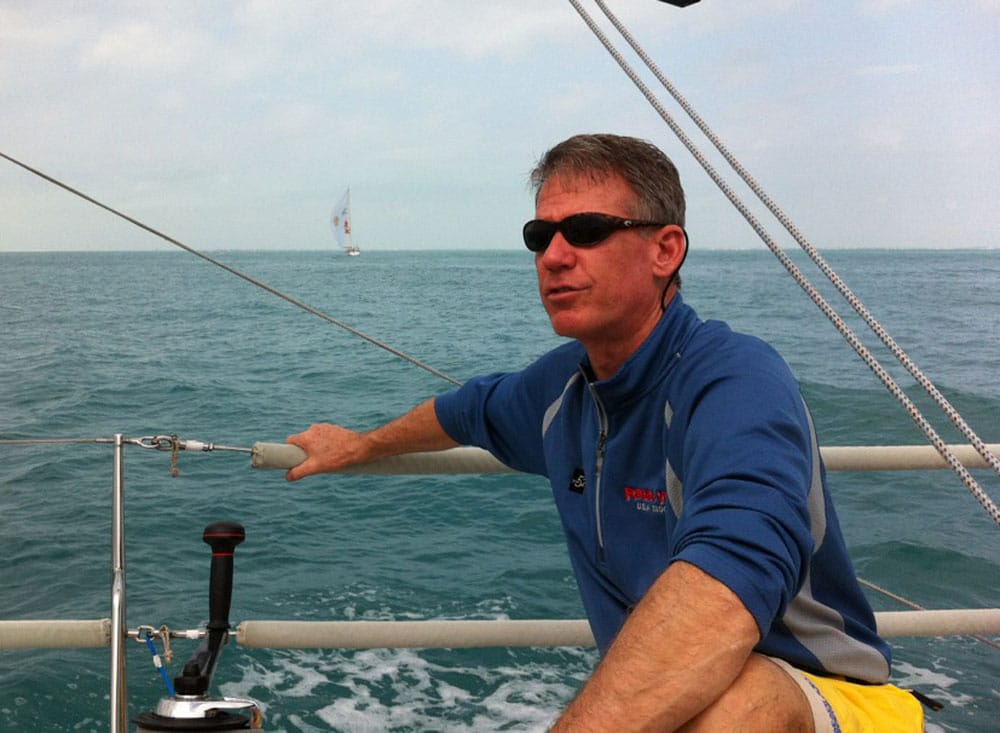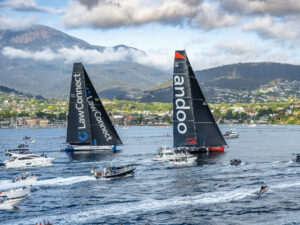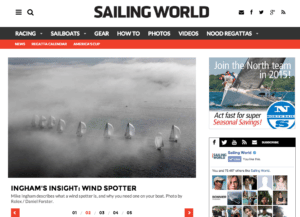
120113_Robin_Team
I was surprised when, early Friday morning, Robin Team fired up the Yanmar with just six-tenths of a mile to go to the finish line and decided to retire from the 2012 Key West Race. For the previous 36 hours, he’d been the primary reason we hadn’t pulled the plug. And he’d had plenty of reason and opportunity: Like when our main halyard on his J/122 Teamwork snapped an hour into the race and it took us the better part of two hours to get a replacement threaded through the mast, leaving us hopelessly behind our competition in PHRF A. Or when the water glassed off the countless times during the course of the race, leaving the speedo registering the dreaded triple zeroes. Or when it became apparent that we were unlikely to finish within 36 hours a race that usually takes less than 24.
As much I, like Team, like to finish what I start, I didn’t disagree with his decision as we sat struggling to hold position in the Key West channel against a nasty 1.5-knot current. I had begun to wonder if we were simply not meant to finish this race.
Additionally, a number of our crew had work-related things to do that day. For one other, there was a plane to catch. And who knew when the breeze would’ve built enough to make way against the current. We could’ve kedged for most of the early morning and not gotten any closer to making the finish. Team’s buoy-racing crew was due into Key West that afternoon and the boat had to be switched into buoy-racing mode so they could get in two days of practice over the weekend. And while Team is a big fan of the Key West Race—he won IRC B in 2010—the effort and money spent on that event pales in comparison to what has been (and will be) put into the 5-day circus known as Quantum Key West Race Week.
As soon as our main halyard parted, we knew our chances of picking up a trophy were very limited. But the boat had to get to the southern end of U.S. 1, and sailing is more fun than motoring. So we solved the problem and carried on. We sailed hard, we picked up time—we think—we bonded as a crew, and we learned a lot. Even with a DNF next to our name, it was a worthwhile experience. My mind is still a little scrambled from the lack of sleep, but a couple of things stick in my mind.
There aren’t many more difficult repairs than running a new main halyard while at sea. It took us two hours, with two different people up the rig for 20 to 30 minutes each. As one of those two people, I can tell you it was a particularly shattering experience and I’m not looking forward to ever doing it again. However, it was better than the alternative: dropping out after an hour of sailing. Of course, few people seriously plan for this repair. We had the necessary equipment: a long feeder line and a big handful of lock nuts to help drag the line down the rig. Using it was another story. Getting the nuts up and over the sheave was a difficult task. The fact that the top of the mast was pitching violently through a 10- or 15-foot arc didn’t help. Two suggestions: Firstly, get to know the top of your rig. Know the layout, know the equipment. Take some pictures to look at while on deck. Have a plan for leading a new halyard, or re-leading the old one, even if that means using a 2-to-1 halyard 1-to-1. It’s better than nothing, though I would go easy on the vang, sheet and Cunningham the rest of the way. Secondly, I’ve often heard that bicycle chain makes for a great weight. The collection of nuts worked OK, but my experience leads me to believe a 3-foot section of bike chain would be better. One issue with the string of nuts was that as it drops down the rig, especially in rough seas, it’s flexible enough to wrap around other halyards. We believe this happened to us, compromising our headsail halyards for the rest of the race.
Never underestimate the seriousness with which people will approach a distance race start. We got a little careless, set up too early for the boat end and got squeezed up nearly into irons by not one, but two boats. Ugh. It’s just not worth the hassle. This goes double for you if you’re one of the faster boats. Slow boats love to make life difficult for the speedsters.
AdvertisementNo overnight race is too short for a watch system. Having now done a handful of these races, I believe firmly in the value of everyone on the crew knowing two things at all times: one, when they will get a little down time to get down below and catch a brief nap, and two, who is ultimately in charge of sailing the boat at any given time, and therefore responsible for making it go as fast as possible. On Teamwork, we broke our nine crew into three watches. We sailed all hands on deck until sunset. From that point on: one trio was on, sailing the boat. One was on standby, on deck, geared up, but resting on the rail (windward or leeward depending on wind strength). The third was below, catching some rest. Even if you can only spare having one person belowdecks at any time, it’s worth drawing up a schedule. Short-distance races, especially those like the Key West Race where the tactical options are constrained by the course, are often won or lost at night and due to boatspeed. The teams that can focus and keep the boat going to it’s potential, win. When it gets light, or shifty, it’s easy to slack off, especially if you’re tired and/or not really sure who is supposed to be pushing the boat toward the finish.
Never underestimate the value of a good specialty sail. Prior to this race, the Teamwork crew had flown the Code 0 once, and never in a race. I’m sure there was some doubt as to it’s being worth the substantial cost. However, it was our weapon of choice in this race and was extremely effective in its range. Late Thursday night we were reaching along the lower Keys in light air and flat water and the Zero had us going the windspeed or close to it, 5 to 6 knots in 5 to 7 knots of breeze, and catching the boats around us. Light air reaching is usually a weak point of a traditional windward-leeward, buoy-racing sail plan. This sail earned its keep in this race. Of course, it’s not the idea sail for every boat. But for a team that’s going to focus on distance racing, having the right tools can be a huge lift.
Know When to Fold ‘Em: Distance racing should always be about the experience. About finding your limits. About the sublime pleasure of a 10-knot reach under starry sky. About a team learning to work together in adverse circumstances. About getting away from the routine of normal life. The results are a reason to do the race, but not the reason. When the fun factor disappears completely, it’s time to consider packing it in. Sitting in the Key West channel, making no progress over the bottom, we had nothing left to prove by finishing that race. We weren’t going to win. Retiring should never be taking lightly—and I think the inherent stigma against “quitting” is a good deterrent. But sometimes it’s better to get to the dock celebrate the experience and make sure everyone is psyched for the next overnighter.
Advertisement









